We may not have the course you’re looking for. If you enquire or give us a call on 01344203999 and speak to our training experts, we may still be able to help with your training requirements.
Training Outcomes Within Your Budget!
We ensure quality, budget-alignment, and timely delivery by our expert instructors.

A Pie Chart in Excel or a Circle Chart helps to represent statistical data in the form of parts of a circle. Each part or section displays a piece of the pie. This type of Chart in Excel is used to display only a single sort of data set. As a result, users find it easy to learn How to Make a Pie Chart in Excel and work with them.
If you fall under the beginner category of Excel users who do not know how to create Pie Charts, then you at the right place. You can create Pie Charts by following a few simple steps. Read on to learn How to Make a Pie Chart in Excel.
Table of Contents
1) What is Pie Chart in Excel?
2) How to Make a Pie Chart in Excel?
3) How to edit a Pie Chart in Excel?
5) How to prepare different types of Pie charts in Excel?
6) How to customise a Pie Chart in Excel?
7) How to explode an Excel Pie Chart?
8) How to rotate an Excel Pie Chart?
9) How to Create a Pie Chart in Excel easily?
10) Conclusion
What is Pie Chart in Excel?
We all love Pie Charts because they are easy to understand. However, we often need help with the task of creating these Charts. Especially when drawing Pie Charts by hand, we find it challenging to represent percentages accurately.
Here, Microsoft Excel finds its use. MS Excel allows you to create a Pie Chart in a few minutes. What’s more? You can use Excel’s chart customisation features to make your Pie Chart appear even more professional.
A Pie Chart or commonly known as a circle chart, is used to plot statistical data in different sections of a circle. These sections are similar to slices of a pie. You can only include a single data series when creating a Pie Chart.
Also, the Pie Chart sections don’t include any negative values or zeros. Instead, a negative value is represented in its positive form in each area. The description contained in these sections is known as a category. The number included in each category is known as value. The total of all categories in a Pie Chart is 100%.
A Pie Chart should include only seven categories. However, some variations allow Pie Charts to show more than seven categories. Read on to learn how to create these categories in a Pie Chart.

How to make a Pie Chart in Excel?
Creating a Pie Chart has become simple due to the use of Excel. Now, you can create a Pie Chart with the help of a few clicks. Here's a complete breakdown of the steps you need to take to learn How to Make a Pie Chart in Excel:
Organising the data for your Pie Chart in Excel
To get started, you’ll have to organise the data in one row or column so that you can plot only a single data series in the Pie Chart. Your spreadsheet can also include a separate row or column representing category names. The category names are included in the first row or column that needs to be selected. Besides, these category names are displayed as data labels in the Pie Chart. You should keep the following in mind when organising your data for an Excel Pie Chart:
1) Remember to plot only a single data series in your chart.
2) The data values should be more than zero.
3) Don't leave any column or row empty.
4) The number of categories should be at most seven or nine. A Pie Chart with multiple pie slices is challenging to analyse and understand.
In our Excel Pie Chart tutorial, we are using the following data to create a pie graph:
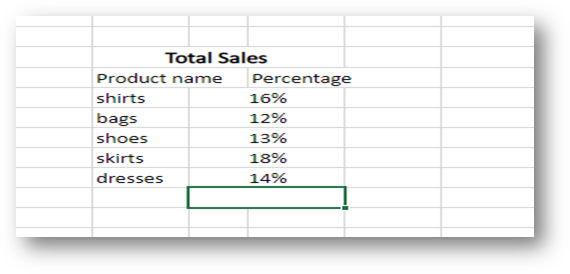
Include a Pie Chart in Excel worksheet
Once your source data is organised properly, you’ll have to select it. Next, click on the Insert tab. Now, choose the type of chart you want. In our example, we will create a 2-D Pie Chart:
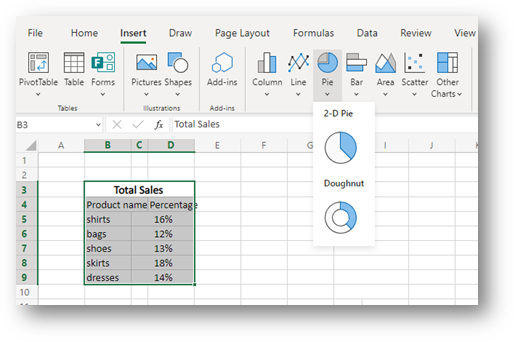
Tip: You can select the headings of the row and column if you want these headings to appear in the Pie Chart’s title.
Choose the style of the Pie Chart you want
Once the Pie Chart is included in the worksheet, you can visit the Design tab > Change Chart Type. You can click on different Pie Chart styles and select the best one that suits your data.
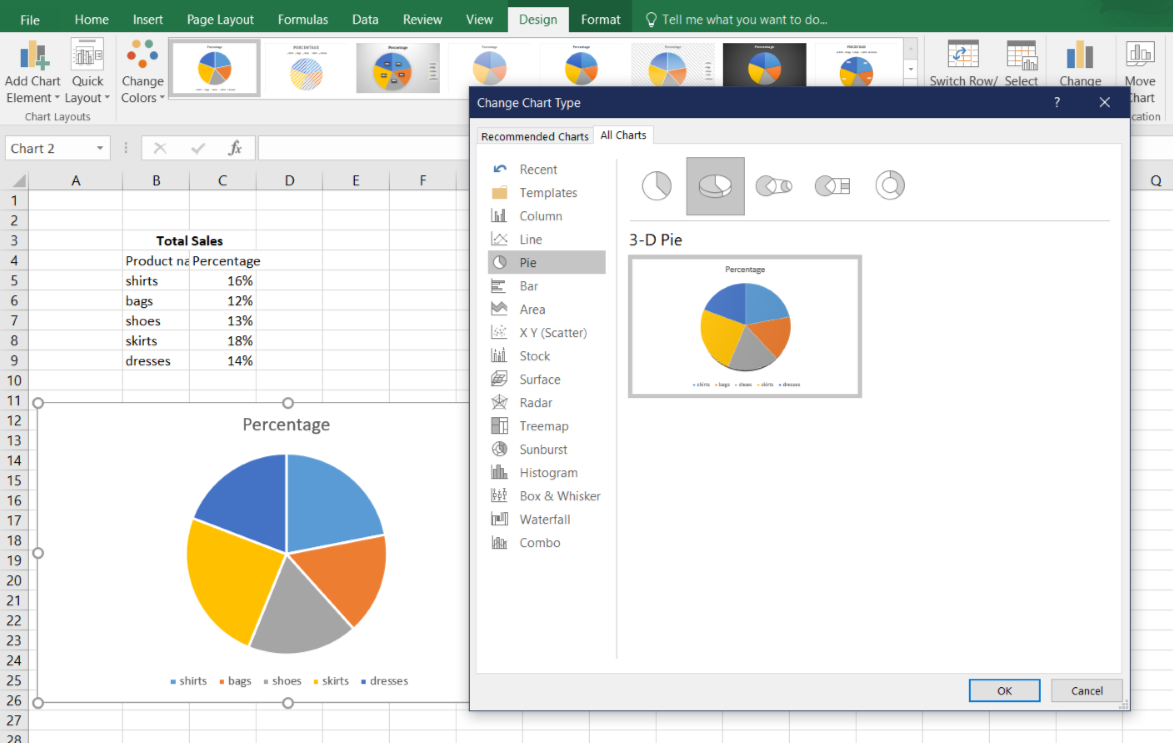
Build your career as a Data Analyst - sign up for Data Analysis Training using MS Excel!
How to edit a Pie Chart in Excel?
Are you not satisfied with how your chart looks? Then you can modify it to fit your needs. Follow the below-mentioned steps to edit your Chart:
a) If you want to change the background colour of your Chart, then click on the paint bucket icon under the ‘Format Chart Area’ sidebar. Now, choose the fill type and the background colour.
b) If you want to rewrite anything, expand the text, or move the text to a new area of your pie chart, then click on the text within the pie chart itself.
c) You can change the border of your pie chart including border transparency, width, and colour in the Format Chart Area.
d) Click on the pentagon shape in the Format Chart Area sidebar to change the pie chart box itself. Get the shadow you want by toggling the bar across ‘Transparency’, ‘Size’, ‘Blur’, and ‘Angle’.
e) To change the colour of your pie chart, you can click the colour paint palette at the top left of Excel. Or, simply you can click on the pie chart piece and toggle onto the paint section to choose a new colour.
f) You can change the Chart title by clicking on the three bars graph icon in the top left of the Excel.
g) You can change the place of your labels on the pie chart by clicking the ‘Data Labels’ on the same three bar graph icon.
h) If you wish to switch the data in the pie chart, then click ‘Switch Row/column ‘ to view alternate information aligned from your original data set.
How to prepare different types of Pie Charts in Excel?
Excel allows you to create different types of Pie Charts. Some of these are as follows:
2-D Pie Chart
2-D Pie Chart is a commonly used Pie Chart in Excel. You can create it by clicking on the Insert tab. Next, you’ll have to click on the Charts group. Now, you can choose the 2-D Pie Chart icon.
This pie chart always shows the items’ size making up the data series which is proportional with the total of items in the series.
The following are the data requirements for 2D Pie Charts:
a) The data set has a numeric column with values that can be interpreted as numbers.
b) The data set contains one numeric row.
c) The column meant for wedges in the chart must be specified by setting the ColumnIndex property to 0. For automatic search of data, set this data to –1. In this case, the first numeric column encountered will be used for the wedge's values.
d) If you want to bind the 2-D pie chart to a series object, then you have to gather information on the series binding requirements.
3-D Pie Chart
The features of 3-D Pie Charts are similar to 2-D Pie Charts. However, the data entered is displayed on a third-depth axis. Below are the steps to create a 3-D Pie Chart:
a) You can write your data in a table with appropriate information in each column.
b) Select all the elements of the table. Now, go to the insert section and locate Pie Charts under the Charts sub-section. Then, choose a 3-D Chart that best suits the purpose of your work.
You can create a different pie if there are several small slices in your Pie Chart. Then, you can display the remaining pieces on it. A Bar of Pie Chart or a Piece Pie of Pie can be created by following these steps:
a) Select the data range.
b) Click on the Pie and Doughnut button in the Charts group on the Insert tab.
c) Choose Bar of Pie or Pie of Pie.
d) Right-click in the chart area and select Format Data Series in the popup menu.
e) Select the data to be displayed in the second pie by clicking on the Format Data Series in the Series Options Tab.
There are several ways to choose which slice goes in the secondary Pie or bar chart: Split series by position, Split series by Value, Split series by Percentage Value, and Split series by Custom.
Doughnut chart
The Doughnut Charts show data in various rings. Each ring of a Doughnut Chart shows a different data series. Follow the below steps to create a Doughnut Chart using Excel:
a) First, select the data range that needs to be shown. Then, click Insert> Other Charts>Doughnut
b) A Doughnut Chart will gte inserted into your worksheet. Now, you can right-click at all series and select Data Labels from the context menu to add the data labels.
c) A Simple Doughnut Chart has now been created.
How to customise a Pie Chart in Excel?
If the objective of the Pie Chart you are creating in Excel is to showcase trends in the data, you can create the default chart. However, if you want to create a professional graph for your next presentation, you should make a few enhancements. So, let’s learn about a few customisation tips:
How to add labels to your Pie Chart?
A good Pie Chart should be easy to understand. You can add data labels to your Pie Charts as it will simplify the message of your graph. However, a Pie Chart with a data label can make calculating the exact percentage of the slices easier. Thus, you can include a title for the whole data series or each data point.
These labels can vary as per the data you’re willing to outline in the pie graph. You'll have to follow the below-mentioned steps to add data labels to an Excel Pie Chart:
Add data labels to an Excel Pie Chart
You can add labels to different data points. You’ll have to tap the Chart Elements button on the pie graph’s upper-right corner to add a label.
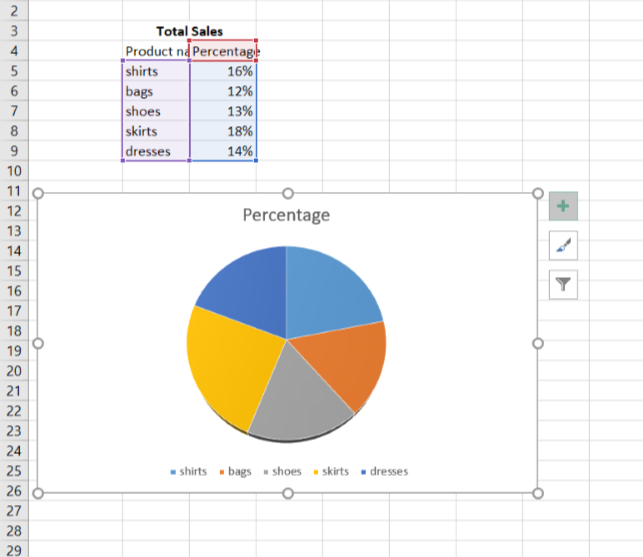
Now, you’ll have to choose the Data Labels option.
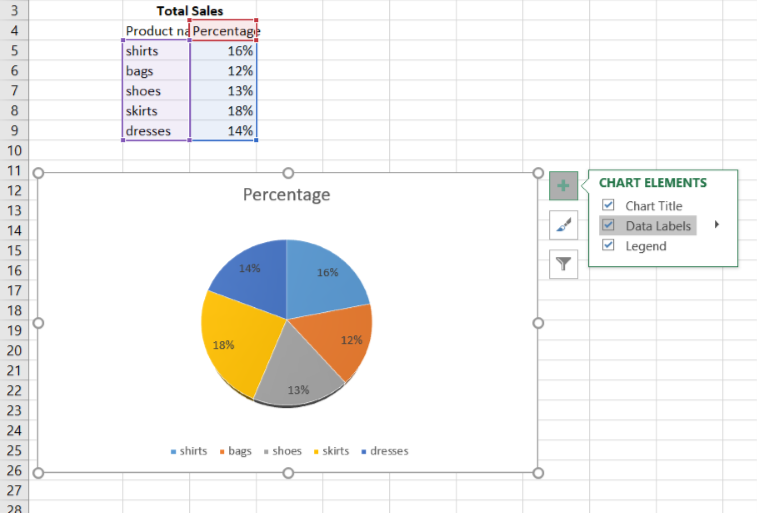
If you’re willing to change the location of labels on the Excel Pie Chart, you can get started by selecting the arrow near the Data Labels.
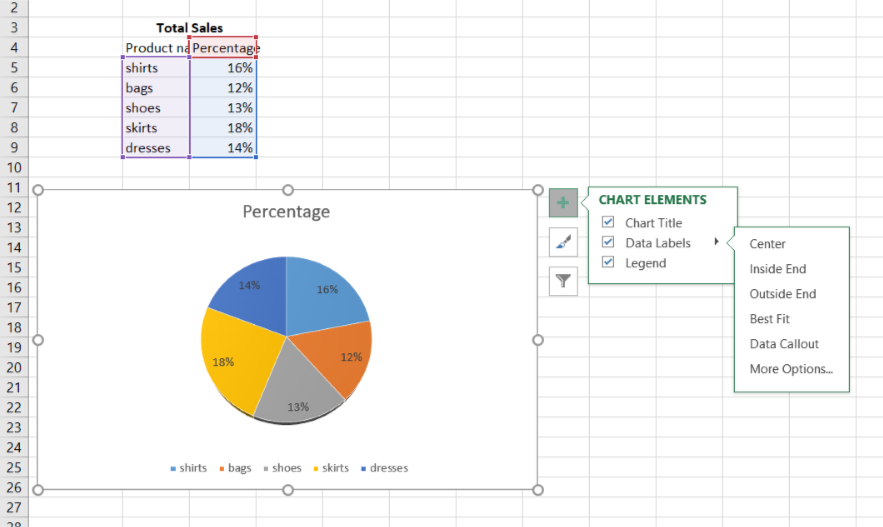
Show data categories on various data labels
If the Excel pie graph you’ve created includes more than two-three slices, you should add levels to them directly. Then, your users will no longer have to browse between the pie and the legend to discover the description of each slice.
An easy way to show data categories on different labels is to choose the best-predefined chart layouts. You’ll have to select the Design tab > Chart Styles group> Quick Layout to do this. Then, choose the layouts that consist of data category labels.
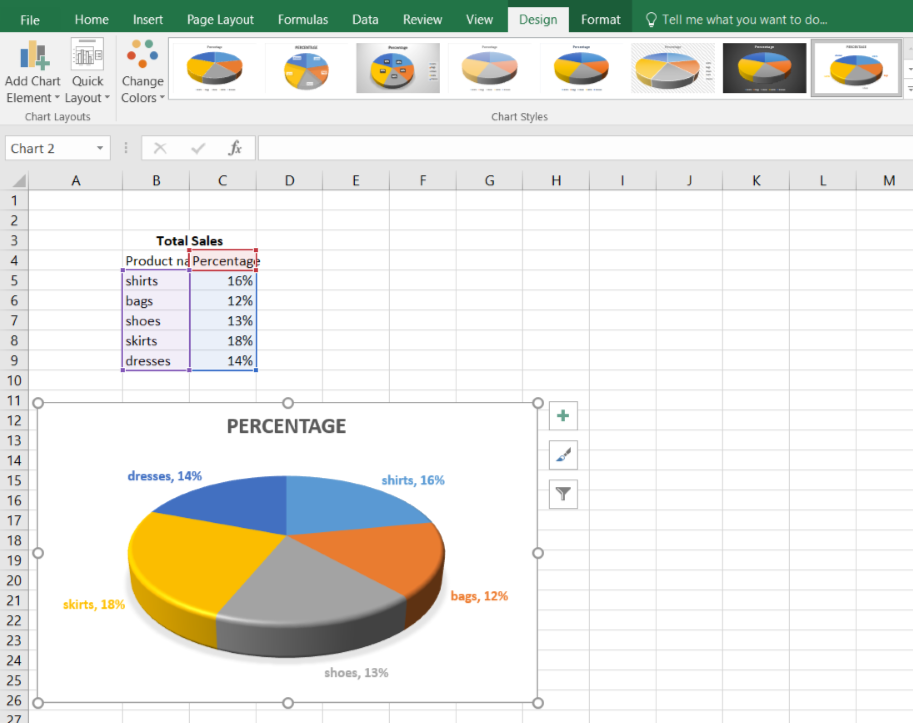
Now, you can go to the Chart Elements > Data Labels to open the Format Data Labels panel on the worksheet’s right side. First, click on the Label Options tab. Next, click on the Category Name tab.
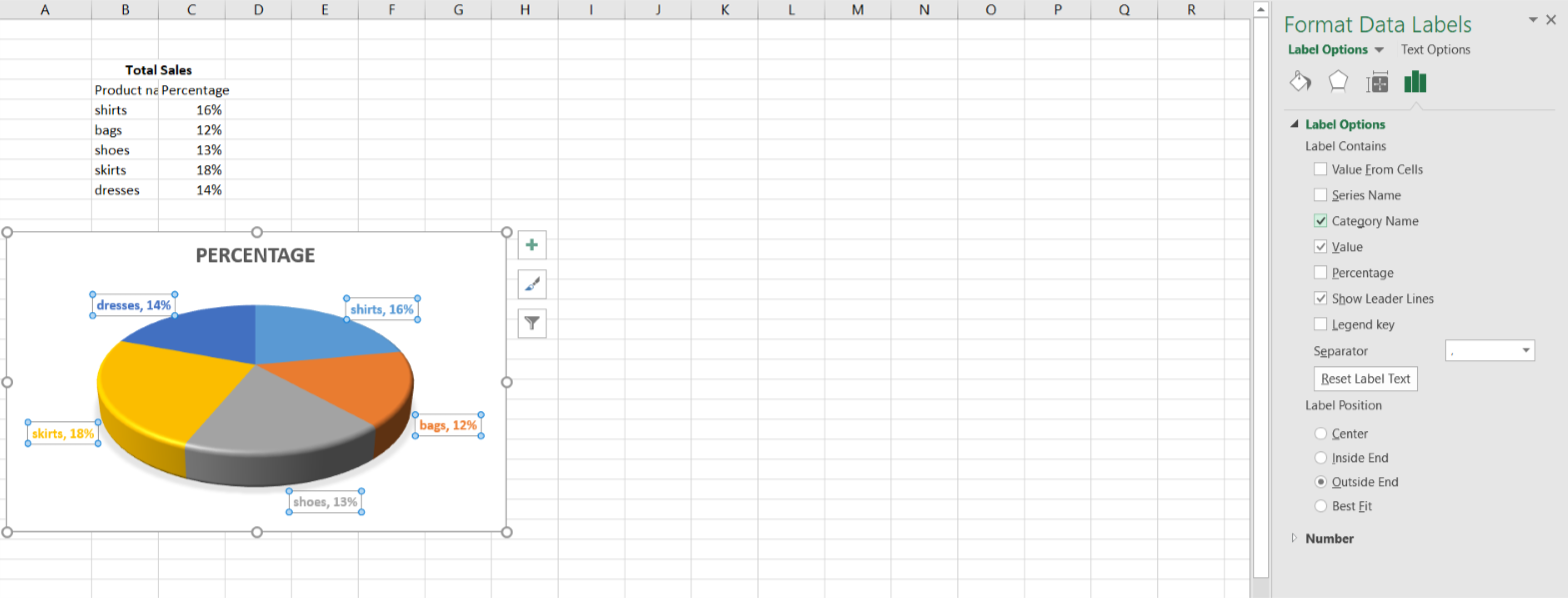
Besides, you’ll find the below-mentioned tips helpful:
a) Below the Label Contains tab, you can click on the data that should be showcased as labels.
b) You can click on the separator option. Now, from the drop-down list, you’ll have to choose ways to differentiate the data displayed on the labels.
c) Below Label Position, you’ll have to select where to put data labels.
Show percentage on Pie Charts in Excel
The source data you plot on your Pie Chart can include percentages. The % symbol will be shown automatically on the data labels. First, you’ll have to select Chart Elements and go to Data labels. If the source data includes numbers, you’ll have to configure these data labels to represent either percentages or original values. Here's how you can do that:
a) Right-click on the slice of your Chart. Now, choose Format Data Labels.
b) Under the Format Data Labels pane, you can choose either the Percentage or Value box. Also, you can select both boxes at the same time. Excel will calculate the percentages automatically, where the value of the entire pie is 100%.
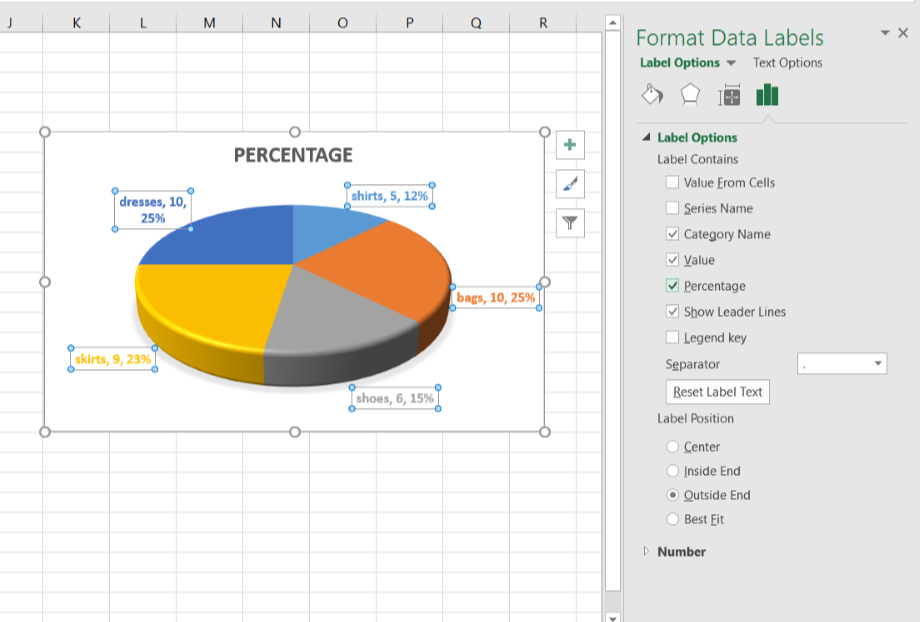
Organising the Pie Chart slices as per their size
Pie charts become easy to understand when their slices are arranged in descending order (i.e., from large to small). You can do this quickly by placing the source data. You can set your source data in descending order to get started.
Changing the colours of the Pie Chart in Excel
If you don’t like the default colours shown in the Excel Pie Chart, you can choose from the two options listed below:
a) Change the colour of each slice
Or,
b) Modify the colour theme of your entire pie graph
Change the colour of each slice
The number of colour themes available for an Excel chart is limited. So, if you want to create an attractive and professional Pie Chart, you’ll have to select the colour of each slice separately. For example, if you wish to include data labels inside each slice and the theme colour is dark, the black text is not visible. To get rid of this issue, you can choose a suitable colour theme for your text.
Additionally, if you want to modify the colour of a particular slice, select the slice and click on it. Now, click on the Format tab, choose Shape Fill, and select the colour you like.
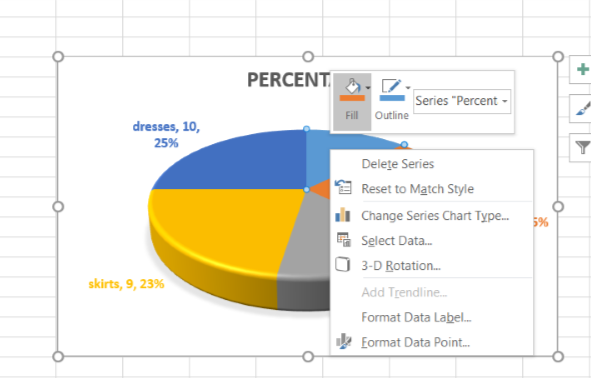
Modify the colour theme of your entire Pie Chart in Excel
You'll have to choose the Design ribbon if you want to select a new colour theme for the Excel pie graph. So, click the Change Colours button and browse through the colour themes. Finally, you can choose the colour theme you like.
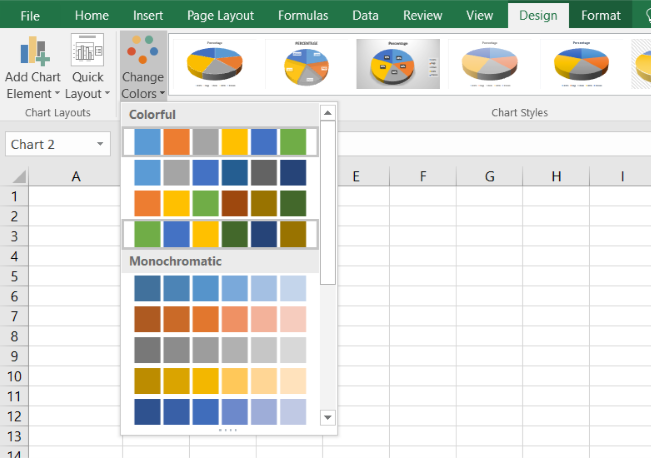
Format a Pie Chart in Excel
When you want to create an Excel Pie Chart for presentation purposes or export it to a new application, you should make it more appealing. To use Excel’s formatting features, you can right-click on any slice of the Excel Pie Chart.
Next, you can open the Format Data Series panel by clicking on the Pie Chart. You'll have to choose the Effects tab from the Format Data Series pane. Now, you can apply and check effects such as Soft Edges, Glow, or Shadow. It will help you select the best one out of them. You can also browse through other options under the Format tab like:
a) Increase or decrease the width and height of the Pie Chart
b) Change the outline colours and shape fill
c) Use various shape effects
d) Use WordArt styles to modify the text elements
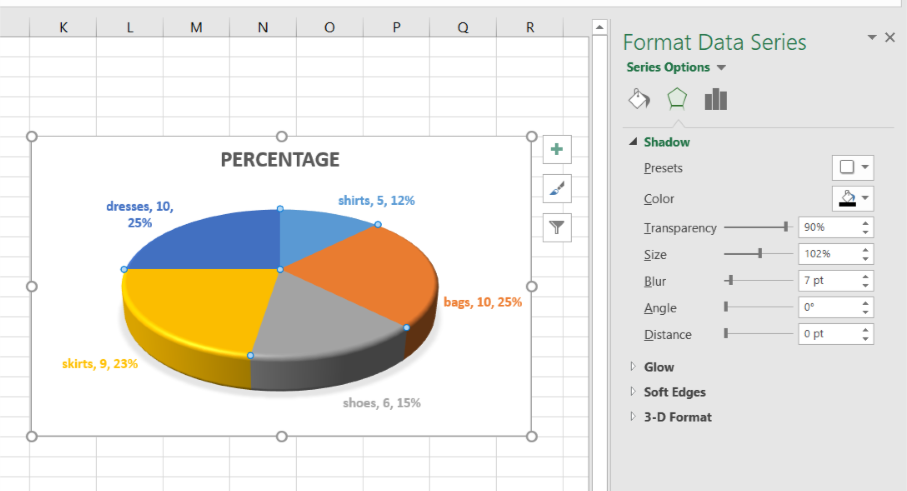
To use the formatting mentioned above features, you’ll have to choose the element in the pie graph that needs formatting. For example, Excel allows you to format features such as chart titles, slices, data labels, or legends. Now, click on the Format tab on this ribbon. This will activate the essential formatting features. On the other hand, the non-relevant features will be represented in grey.
Get expertise in Data Visualisation, register in for our Microsoft Excel Associate MO200!
How to explode an Excel Pie Chart?
If you want to highlight a particular section in the Pie Chart, you can use the explode option. You can get started by exploding a slice of the Pie Chart. To do this, you’ll have to double-click on the slice you want to extract. Next, you can pull away the slice by dragging it with the cursor. Afteryou have performed these steps, you Pie Chart will look something like the following image:
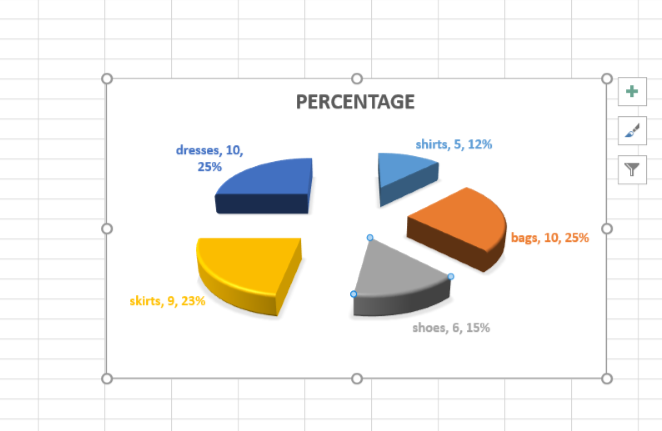
How to rotate an Excel Pie Chart?
If you want to rotate a Pie Chart in Excel, you’ll have to click on the Pie Chart twice. Next, you’ll have to select the “Format Data Point” option. Next, you have to toggle the first slice’s Angle and rotate it to a certain degree.
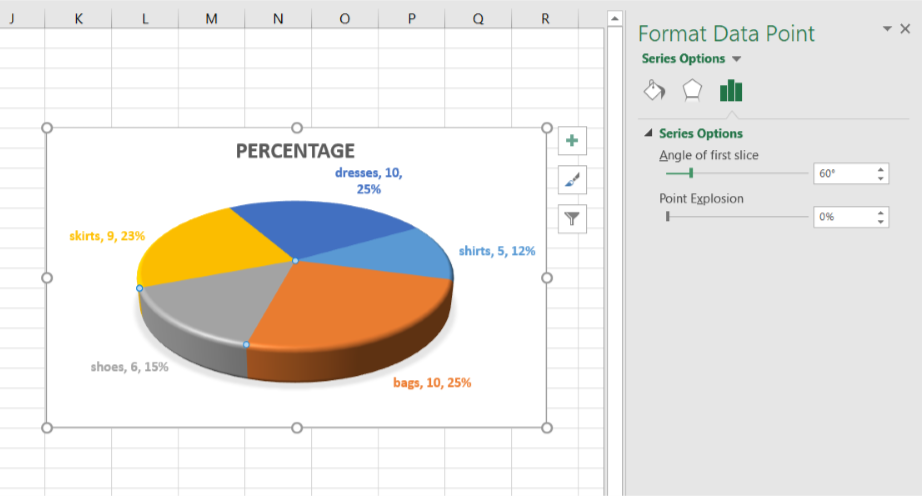
Learn how to create advanced formulas in MS Excel - sign up for our Microsoft Excel Expert Training!
How to Create a Pie Chart in Excel easily?
Thefollowing are some practices that you must follow while preparing these Charts:
1) Arrange the slices according to their size: To simplify the Pie Chart percentage calculation task, you can sort its slices. You can arrange the slice from large-sized to small-sized or small-sized to large-sized.
2) Categorise slices: If your Pie Chart includes numerous slices, you’ll have to categorise them as groups. Next, you’ll have to use a particular colour for a specific group. Similarly, you’ll have to use a unique shade for a particular shade.
3) Create an “other category”: If the Pie Chart includes multiple small slices, you can create a separate “other category”. You can also grey out these small slices.
4) Rotation: You can rotate your Pie Chart. It helps the small slices to appear in the front. Include a few data categories: You should only include one slice in your Pie Chart as it leads to clarity. If you want to plot over seven data categories, you can use a bar Pie Chart or a pie of Pie Chart. Now, you can include the small categories in the secondary chart.
5) Use of a legend: You can label the slices of the Pie Charts directly. Avoid using a legend, as your users will find it challenging to simultaneously evaluate the pie and the legend.
6) Use of 3-D effects: When preparing a single chart, you should avoid using several 3-D effects. Charts with several 3-D effects can distort the meaning of the data.
Don'ts:
1) Avoid excessive categories:
Steer clear of cluttering the Pie Chart with too many categories. If you have more than 7 data categories, consider alternatives like a pie of pie or bar of Pie Chart to manage complexity.
2) Skip the legend:
Instead of using a legend, directly label the Pie Chart slices. This eliminates the need for readers to switch between the legend and the chart, enhancing accessibility.
3) Minimal 3-D effects:
Refrain from incorporating excessive 3-D effects in a single chart, as they can distort the chart's message. Keep visual elements clean and straightforward to maintain clarity.
By adhering to these do's and don'ts, you can ensure your Pie Charts are aesthetically pleasing and effectively convey information to your audience.
Sign up and learn the top ten Excel shortcuts with our Microsoft Excel Masterclass!
Conclusion
Excel users find learning How to Make a Pie Chart in Excel easy. You can follow the tips provided in the blog to create an easy-to-understand and professional-looking Pie Chart in Excel. To do this, users can take the help of features such as colours, data labels, chart titles etc.
Learn how to create advanced formulas in MS Excel - sign up for our Microsoft Excel Expert!
Frequently Asked Questions

To create a Pie Chart in Excel follow these steps:
a) First, select the data range that you want to visualisee.
b) Then, go to the "Insert" tab in the Excel ribbon.
c) From there, choose the "Pie Chart" option and select the specific chart style that suits your data.
d) Excel will automatically generate a pie chart based on the provided data, providing you with a visual representation of the data distribution.

Once you've created a Pie Chart, here’s how you can add percentages:
a) After generating the chart, click on it to select it.
b) Then, choose the "Add Data Labels" option. Right-click on the labels and select "Format Data Labels."
c) In the Format Data Labels menu, check the "Percentage" box.
d) This will display the percentages on each slice of the pie chart, giving a more precise representation of the proportion of each category.

The Knowledge Academy takes global learning to new heights, offering over 30,000 online courses across 490+ locations in 220 countries. This expansive reach ensures accessibility and convenience for learners worldwide.
Alongside our diverse Online Course Catalogue, encompassing 17 major categories, we go the extra mile by providing a plethora of free educational Online Resources like News updates, Blogs, videos, webinars, and interview questions. Tailoring learning experiences further, professionals can maximise value with customisable Course Bundles of TKA.

The Knowledge Academy’s Knowledge Pass, a prepaid voucher, adds another layer of flexibility, allowing course bookings over a 12-month period. Join us on a journey where education knows no bounds.

Discover an array of Microsoft Excel Courses at The Knowledge Academy, featuring specialised training in Microsoft Excel, PowerPoint, Project Training, etc. Designed for different skill levels, our courses provide the necessary technical expertise with Visual Basic for Applications in Excel.
Whether you're starting out or looking to upgrade your Skills, immerse yourself in our Office Application Blogss for further understanding and expertise. Embark on a journey with us to elevate your Office Applications proficiency!
Upcoming Office Applications Resources Batches & Dates
Date
 Microsoft Excel Course
Microsoft Excel Course
Mon 13th May 2024
Mon 3rd Jun 2024
Mon 17th Jun 2024
Mon 1st Jul 2024
Mon 15th Jul 2024
Mon 5th Aug 2024
Mon 19th Aug 2024
Mon 2nd Sep 2024
Mon 16th Sep 2024
Mon 7th Oct 2024
Mon 21st Oct 2024
Mon 4th Nov 2024
Mon 18th Nov 2024
Mon 2nd Dec 2024
Mon 9th Dec 2024
Mon 16th Dec 2024







 Top Rated Course
Top Rated Course


 If you wish to make any changes to your course, please
If you wish to make any changes to your course, please


